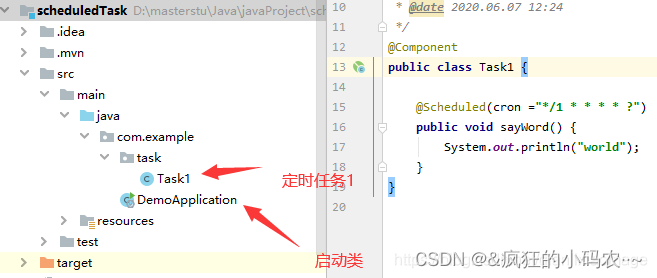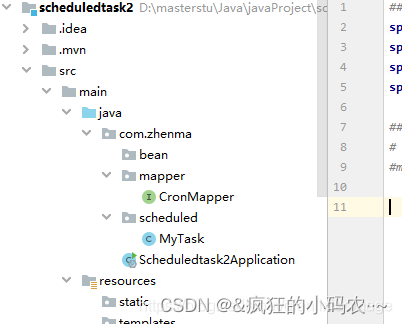Spring boot开启定时任务的三种方式
一、基于注解的方式
首先,打开idea,创建springboot项目,无需引入任何jar,springboot自带定时。
然后,在启动类中用注解@EnableScheduling进行标注,表明此类 存在定时任务。在定时执行的方法之上添加注解
@Scheduled(cron ="*/6 * * * * ?")。
package com.example.demo;
import org.springframework.boot.SpringApplication;
import org.springframework.boot.autoconfigure.SpringBootApplication;
import org.springframework.scheduling.annotation.EnableScheduling;
import org.springframework.scheduling.annotation.Scheduled;
@SpringBootApplication
@EnableScheduling
public class DemoApplication {
public static void main(String[] args) {
SpringApplication.run(DemoApplication.class, args);
}
@Scheduled(cron ="*/6 * * * * ?")
public void sayHello() {
System.out.println("hello");
}
}
点击启动,即可看到控制台6秒输出一次“hello”。
当然,定时任务也可以放在其他类中。例如创建类Task1。
package com.example.task;
import org.springframework.scheduling.annotation.Scheduled;
import org.springframework.stereotype.Component;
/**
* @Description
* @ClassName Task1
* @Author User
* @date 2020.06.07 12:24
*/
@Component
public class Task1 {
@Scheduled(cron ="*/1 * * * * ?")
public void sayWord() {
System.out.println("world");
}
}
然后可以看到控制台的输出结果:


这里有个要注意的细节,就是启动类需要能扫描到定时任务类,否则定时任务启动不起来。不仅需要@Component注解,也需要将启动类位置位于定时任务类之上。如下图:
笔者就是犯了这样的错,一直没启动起来。
@Scheduled除过cron还有三种方式:fixedRate,fixedDelay,initialDelay
cron:表达式可以定制化执行任务,但是执行的方式是与fixedDelay相近的,也是会按照上一次方法结束时间开始算起。
fixedRate:控制方法执行的间隔时间,是以上一次方法执行完开始算起,如上一次方法执行阻塞住了,那么直到上一次执行完,并间隔给定的时间后,执行下一次。
@Configuration
@EnableScheduling //开启定时任务
public class ScheduleTask1 {
//每3秒执行一次
@Scheduled(fixedDelay = 3000)
private void myTasks() {
System.out.println("I do myself per third seconds");
}
}
fixedRate:是按照一定的速率执行,是从上一次方法执行开始的时间算起,如果上一次方法阻塞住了,下一次也是不会执行,但是在阻塞这段时间内累计应该执行的次数,当不再阻塞时,一下子把这些全部执行掉,而后再按照固定速率继续执行。
@Component
@EnableScheduling //开启定时任务
public class ScheduleTask2 {
//每10秒执行一次
@Scheduled(fixedRate = 10000)
private void myTasks2() {
System.out.println("我是一个定时任务");
}
}
initialDelay:initialDelay = 10000 表示在容器启动后,延迟10秒后再执行一次定时器。
@Component
@EnableScheduling //开启定时任务
public class ScheduleTask {
//容器启动后,延迟10秒后再执行一次定时器,以后每10秒再执行一次该定时器。
@Scheduled(initialDelay = 10000, fixedRate = 10000)
private void myTasks3() {
System.out.println("我是一个定时任务3");
}
}
二、cron解释
cron
cron 用法跟linux下是一摸一样的,如果你搞过linux下的定时,那么必然很熟悉。
结构
cron表达式是一个字符串,分为6或7个域,每两个域之间用空格分隔,
其语法格式为:“秒域 分域 时域 日域 月域 周域 年域”
取值范围
域名 可取值 可取符号(仅列部分常用)
秒域 0~59的整数 * - , /
分域 0~59的整数 * - , /
时域 0~23的整数 * - , /
日域 1~31的整数 * - , / ? L
月域 112的整数或JANDEC * - , /
周域 17的整数或SUNSAT * - , / ? L #
年域 1970~2099的整数 * - , /
常例
表达式 意义
每隔5秒钟执行一次 */5 * * * * ?
每隔1分钟执行一次 0 * /1 * * * ?
每天1点执行一次 0 0 1 * * ?
每天23点55分执行一次 0 55 23 * * ?
每月最后一天23点执行一次 0 0 23 L * ?
每周六8点执行一次 0 0 8 ? * L
每月最后一个周五,每隔2小时执行一次 0 0 */2 ? * 6L
每月的第三个星期五上午10:15执行一次 0 15 10 ? * 5#3
在每天下午2点到下午2:05期间的每1分钟执行 0 0-5 14 * * ?
表示周一到周五每天上午10:15执行 0 15 10 ? * 2-6
每个月的最后一个星期五上午10:15执行 0 15 10 ? * 6L
每天上午10点,下午2点,4点执行一次 0 0 10,14,16 * * ?
朝九晚五工作时间内每半小时执行一次 0 0/30 9-17 * * ?
每个星期三中午12点执行一次 0 0 12 ? * 4
每年三月的星期三的下午2:10和2:44各执行一次 0 10,44 14 ? 3 4
每月的第三个星期五上午10:15执行一次 0 15 10 ? * 6#3
每月一日凌晨2点30执行一次 0 30 2 1 * ?
每分钟的第10秒与第20秒都会执行 10,20 * * * * ?
每月的第2个星期的周5,凌晨执行 0 0 0 ? * 6#2
本方法的demo地址: GitHub - SUST-MaZhen/scheduledTask: 基于注解@Scheluded的方式实现定时任务
三、基于接口的方式
使用@Scheduled 注解很方便,但缺点是当我们调整了执行周期的时候,需要重启应用才能生效,这多少有些不方便。为了达到实时生效的效果,那么可以使用接口来完成定时任务,统一将定时器信息存放在数据库中。
在mysql中执行一下脚本插入定时任务:
drop table if exists `scheduled`;
create table `scheduled` (
`cron_id` varchar(30) NOT NULL primary key,
`cron_name` varchar(30) NULL,
`cron` varchar(30) NOT NULL
);
insert into `scheduled` values ('1','定时器任务一','0/6 * * * * ?');
创建一个springboot 项目:我们这里只添加一个mapper,不要bean也不要service以及controller,只是为了演示定时功能而已。demo结构:

数据源基本配置:application.properties
mysql数据源配置
spring.datasource.url=jdbc:mysql://host:3306/dbname?useUnicode=true&serverTimezone=Asia/Shanghai
spring.datasource.username=root
spring.datasource.password=123456
spring.datasource.driver-class-name=com.mysql.cj.jdbc.Driver
Mybatis 配置
配置为 com.example.bean 指向实体类包路径
#mybatis.typeAliasesPackage=com.zhenma.bean
mapper也就是dao:
package com.zhenma.mapper;
import org.apache.ibatis.annotations.Mapper;
import org.apache.ibatis.annotations.Select;
import org.springframework.stereotype.Repository;
@Repository
@Mapper
public interface CronMapper {
@Select("select cron from scheduled where cron_id = #{id}")
public String getCron(int id);
}
task类:
package com.zhenma.scheduled;
import com.zhenma.mapper.CronMapper;
import org.springframework.beans.factory.annotation.Autowired;
import org.springframework.scheduling.annotation.EnableScheduling;
import org.springframework.scheduling.annotation.SchedulingConfigurer;
import org.springframework.scheduling.config.ScheduledTaskRegistrar;
import org.springframework.scheduling.support.CronTrigger;
import org.springframework.stereotype.Component;
/**
* @Description
* @ClassName MyTask
* @Author User
* @date 2020.06.07 15:23
*/
@Component
@EnableScheduling
public class MyTask implements SchedulingConfigurer {
@Autowired
protected CronMapper cronMapper;
@Override
public void configureTasks(ScheduledTaskRegistrar scheduledTaskRegistrar) {
scheduledTaskRegistrar.addTriggerTask(() -> process(),
triggerContext -> {
String cron = cronMapper.getCron(1);
if (cron.isEmpty()) {
System.out.println("cron is null");
}
return new CronTrigger(cron).nextExecutionTime(triggerContext);
});
}
private void process() {
System.out.println("基于接口定时任务");
}
}
运行结果:

从结果中可以看出,是按照每6秒也就是数据库中查询的结果来进行的。

需求:我现在需要每10秒执行一次定时任务,该怎么办呢?对!只需要修改数据库值即可,server无需重启。观察修改后的结果。
感觉好(。・?・)ノ゙嗨哦。
demo地址:GitHub - SUST-MaZhen/scheduledtask2: springboot基于接口的定时任务
四、 基于注解设定多线程定时任务
前面讲到了@Scheduled执行周期任务会受到上次一个任务的执行时间影响。那么可以开启多线程执行周期任务。
创建springboot项目,创建一个多线程定时任务类如下:
package com.example.task;
import org.springframework.scheduling.annotation.Async;
import org.springframework.scheduling.annotation.EnableAsync;
import org.springframework.scheduling.annotation.EnableScheduling;
import org.springframework.scheduling.annotation.Scheduled;
import org.springframework.stereotype.Component;
import java.time.LocalDateTime;
/**
* @Description
* @ClassName MultiThreadTask
* @Author User
* @date 2020.06.07 18:56
*/
@EnableScheduling // 1.开启定时任务
@EnableAsync // 2.开启多线程
@Component
public class MultiThreadTask {
@Async
@Scheduled(fixedDelay = 1000) //间隔1秒
public void first() throws InterruptedException {
System.out.println("第一个定时任务开始 : " + LocalDateTime.now().toLocalTime() + "\r\n线程 : " + Thread.currentThread().getName());
Thread.sleep(1000 * 10);
}
@Async
@Scheduled(fixedDelay = 2000)
public void second() {
System.out.println("第二个定时任务开始 : " + LocalDateTime.now().toLocalTime() + "\r\n线程 : " + Thread.currentThread().getName());
}
}
执行结果如下:

从结果可以看出:第一个任务的执行时间也不受其本身执行时间的限制。两个任务也互不影响。

本文来自互联网用户投稿,该文观点仅代表作者本人,不代表本站立场。本站仅提供信息存储空间服务,不拥有所有权,不承担相关法律责任。 如若内容造成侵权/违法违规/事实不符,请联系我的编程经验分享网邮箱:chenni525@qq.com进行投诉反馈,一经查实,立即删除!
- Python教程
- 深入理解 MySQL 中的 HAVING 关键字和聚合函数
- Qt之QChar编码(1)
- MyBatis入门基础篇
- 用Python脚本实现FFmpeg批量转换
- 光伏效果图是用什么软件建模设计的?
- Pytorch:模型的保存加载、模型微调、GPU的使用
- Netty Review - 优化Netty通信:如何应对粘包和拆包挑战_自定义长度分包编解码码器
- 小程序学习-16
- node+微信+chatgpt 机器人集成
- 视频号链接提取器详细使用指南,教你轻松下载号视频!
- Web网页开发-CSS层叠样式表1-笔记
- 2023年上半年网络工程师真题(1/3)
- 【Verilog】行为级建模
- Java基础知识整理,注释、关键字、运算符